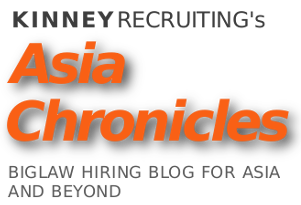Alexis Lamb here. Just returned from a long weekend in Australia where I ran the Gold Coast half marathon on July 4, and decided to pop up to Sydney for some meetings. Since I was just there, I thought I’d share with you all my thoughts on the Sydney market as well as some details about what it’s like to live and work in Sydney.
THE MARKET FOR U.S. ASSOCIATES
The market for U.S. associates in Sydney is not typically strong, although we have made placements in Sydney in the past. Earlier this year we assisted one of our clients in filling a need in Sydney and we are very close to making another placement there as well.
The qualifications to getting a job in Sydney are very similar to the qualifications required to getting a job in HK or Singapore. Candidates with a strong academic background and work experience at a top NY-style “biglaw” practice will be the most competitive (or the only candidates seriously considered). Capital Markets experience, particularly experience with unregistered (Regulation S, 144A) offerings involving foreign issuers, is also required as U.S. practice groups overseas exist primarily to advise overseas issuers on U.S. capital markets laws. Ties to Australia are not typically required.
The market for U.S. associates in Sydney is unfortunately not robust. There are only a small handful of U.S. law firms in Sydney, and only a portion of those firms have a U.S. practice group. Firms with U.S. practice groups include Baker & McKenzie, Sidley and Skadden.
Australia escaped the financial crisis in relatively good shape, suffering a minor blip of a recession in 2009. Australia’s economy is driven by exporting commodities to Asian nations that were experiencing stronger growth than their American and European counterparts. Australian banks also remained healthy.
AUSTRALIAN ICONS
Sydney’s central business district is located right next to Sydney’s two iconic structures – the Harbour Bridge and the Opera House. The relevant subway stop is Circular Quay – named after the semicircle-shaped promenade circling the Opera House – and upon exiting the subway station one is treated to a glorious view of the Opera House and the Harbour Bridge. Most law firms and banks (as well as hotels) are located in this area and offer eye-popping views of the Harbour from their main conference rooms.
A short walk from Circular Quay train station is George Street, the oldest street in Australia. George Street begins in The Rocks, which is the oldest Sydney neighborhood. Much of The Rocks is tourist-friendly but the area does not devolve into a banal tourist-trap. There are several bars, restaurants and shops which retain their historic feel without devolving into theme park kitch. While several companies offer a variety of walking tours of The Rocks, you can still glean its historical significance by strolling through its cobblestoned alleyways and reading a commemorative plaque or two. In the late 1700s, The Rocks was filled with sailors, gangs, plague and gritty characters. While the district currently boasts a lively Sunday market, several modern restaurants and the likes of Burberry and Ralph Lauren, it also has retained a sense of historical preservation and continuity. Certain buildings are constructed to accommodate ongoing archaeological digs and George Street has retained its alignment since 1788, when it was first laid out and became the first road built by Europeans on the continent.
BRUNCH, BOOKSTORES AND BOUTIQUES
My plans to go to Bondi Beach (a 20-minutecab drive from Circular Quay) were scuppered when I awoke on Monday to chilly gray skies and a perpetual weak drizzle. Fortunately, meteorological good fortune is not a precondition to enjoying the delights of Paddington, an inner-city suburb. Two parts Notting Hill, one part Soho (NY), this delightful neighborhood is home to whimsical fashion boutiques, Australian designer flagship stores, bookstores, art galleries, bakeries and cafes, all sprinkled among trees and Victorian townhouses. Getting to Paddington requires a subway ride and a slight walk (or a bus ride) but it’s no more than half an hour away from the CBD.
ON THE ROCKS
After liberating a few dollars at the Paddington boutiques, I returned to The Rocks where I had a pre-flight cocktail at The Argyle – a spacious resto-bar serving up “modern Australian” cuisine and creative cocktails in one of the oldest commercial buildings in Sydney. As my flight was drawing near I decided to give Sydney a proper Australian send-off by ordering the kangaroo steak at a local gastropub. Kangaroo tastes very similar to filet as it is a low-fat red meat and not gamey in the least if prepared correctly.
BASICS
- There are 1.19 Australian Dollars to 1 U.S. Dollar as of the beginning of July, although at the end of May there were 1.23 Australian Dollars to 1 U.S. Dollar and in mid-April there were only 1.07 Australian Dollars to 1 U.S. Dollar.
- Taxicabs, meals, drinks and other goods cost about the same in Sydney as they do in New York. There is a Goods and Services Tax of 10% (a VAT, not a sales tax) on most transactions in Australia which adds to the bill, but tipping in restaurants beyond 10% is uncommon and arguably unnecessary.
- Public transportation – subways, buses and ferries – is clean, cheap and convenient. The train from the international airport to Circular Quay station is AUD$15.80, or around $13 at the current exchange rate.
- Their winter is our summer, although a winter in Sydney can be compared to summer weather in London on many days.
Please feel free to email Robert, Robert or myself at asia@kinneyrecruiting.com for more information on the Sydney markets or anywhere else in Asia.
Related Posts:
- None Found
